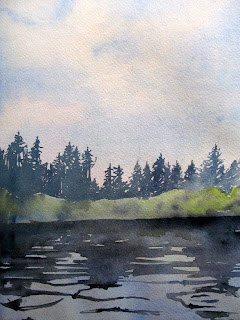 |
| (C) 2016 Dale DiMauro |
On our recent trip to Bar Harbor, Maine we did a bit of hiking in Acadia National Park. We were told island visitors were up twenty percent for Acadia National Park's centennial year. However, we did not encounter congregations of people any larger than in years past.
With the hot weather even reaching Mount Desert Island, we decided to hike in the late afternoon in the shadows of other mountains. This approach worked splendidly one particular day. We hiked Great Head above the ocean and Sand Beach then through a forested valley before climbing to the top of Gorham Mountain just as the evening clouds began to move in. We had views in all directions of vast ocean and numerous mountains.
This watercolor was inspired by our hike up Gorham Mountain. Earlier in our trip we stopped at an art store in Portland, Maine where I picked up a tube of Winsor green (blue shade), which I was eager to try out. There is some Winsor green mixed with burnt sienna in the midground vegetation.







